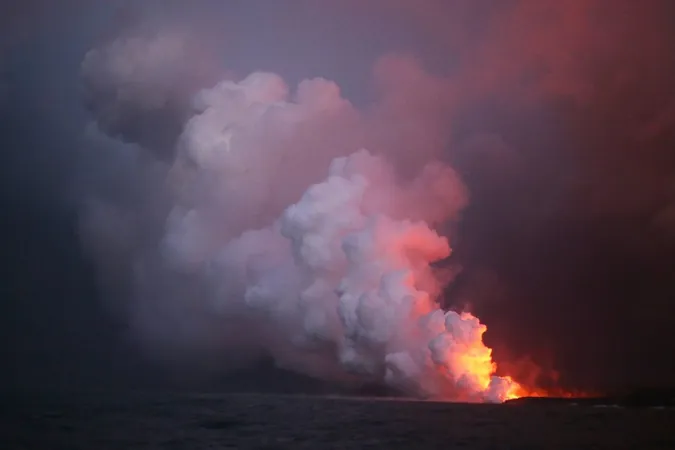
Unraveling the Magma Mystery: The Cataclysmic Eruption That Separated Africa and South America
2025-04-06
Author: Jia
Introduction:
A groundbreaking study reveals that a colossal eruption of magma approximately 135 million years ago may be responsible for the tectonic rift that split Africa and South America apart. This research shines a light on the role of a superheated plume, deep within the Earth's mantle, in the dramatic breakup of the ancient supercontinent Pangaea.
The Fiery Birth of the Atlantic Ocean:
The Atlantic Ocean, in its current form, may owe its existence to violent magma flows that took place between 135 and 131 million years ago, with the most explosive episodes occurring around 134.5 million years ago. During this tumultuous time, a staggering 3.8 million cubic miles (over 16 million cubic kilometers) of molten rock erupted through the Earth's crust. This outpouring solidified into volcanic rock that can still be found across present-day South America, Africa, and the ocean floor.
In regions like Namibia and Angola, thick layers of volcanic rock—some reaching almost 1 kilometer—stand as remnants of these ancient geological upheavals.
Investigating the Geological Forces at Play:
Led by Mohamed Mansour Abdelmalak, a geologist and geophysicist at the University of Oslo, the research team analyzed a variety of data from both land and oceanic sources to piece together the chain of events responsible for this dramatic separation. They propose that a “thermal anomaly,” or an exceptionally hot region located deep beneath Earth's crust, served as a critical catalyst for the eruptions. This aerodynamic hot spot could signify a mantle plume—an upwelling of intensely heated rock—that weakens the overlying crust and drives massive geological changes.
Ecological Impacts and Climate Shifts:
Abdelmalak highlights a fascinating connection between this volcanic activity and significant ecological shifts occurring around 134.5 million years ago. "We witness extinctions and climate disruptions," he noted. By pinpointing the eruption's timeline, the researchers have established a potential connection between these geological events and global ecological repercussions.
While it is widely known that large volcanic eruptions release vast amounts of greenhouse gases that typically promote warming, an interesting twist emerges in this case. Right around 134 million years ago, the Earth experienced a significant cooling event, suggesting a complex interplay between volcanic activity and climate regulation.
Volcanic Weathering: A Natural Climate Balancer:
The eventual cooling may be linked to the process of chemical weathering of volcanic rock. When fresh lava emerges, it interacts with atmospheric gases, such as carbon dioxide, which can help draw down CO2 levels, effectively cooling the climate. This phenomenon illustrates volcanic weathering's dual role as a natural climate regulator, countering the warming typically associated with eruptions.
Ongoing Research and Oceanic Limitations:
Despite the study's convincing findings, uncertainties remain, particularly regarding the geological activity beneath the ocean. "We lack sufficient samples, leaving questions about whether this volcanism is indeed connected to the mantle plume," Abdelmalak stated. The bulk of this uncertainty lies beneath the deep ocean, especially near Argentina and Uruguay, where drilling opportunities are limited. Collecting additional samples from these regions could provide further clarity on the origins of the magma surge.
Modern Parallels:
The study's implications extend beyond ancient history, as current volcanic activity in places like Iceland offers a contemporary analogy. Iceland, sitting atop the Mid-Atlantic Ridge, is an active site for exploring similar geological phenomenons and can help bolster our understanding of the Earth’s dynamic crust.
Conclusion:
This research not only unravels the mystery behind a significant geological event that shaped our planet but also reminds us of the complex relationship between volcanic activity and ecological change. As scientists continue to investigate these ancient eruptions, we may uncover more surprises that deepen our understanding of Earth's geological past.


 Brasil (PT)
Brasil (PT)
 Canada (EN)
Canada (EN)
 Chile (ES)
Chile (ES)
 Česko (CS)
Česko (CS)
 대한민국 (KO)
대한민국 (KO)
 España (ES)
España (ES)
 France (FR)
France (FR)
 Hong Kong (EN)
Hong Kong (EN)
 Italia (IT)
Italia (IT)
 日本 (JA)
日本 (JA)
 Magyarország (HU)
Magyarország (HU)
 Norge (NO)
Norge (NO)
 Polska (PL)
Polska (PL)
 Schweiz (DE)
Schweiz (DE)
 Singapore (EN)
Singapore (EN)
 Sverige (SV)
Sverige (SV)
 Suomi (FI)
Suomi (FI)
 Türkiye (TR)
Türkiye (TR)
 الإمارات العربية المتحدة (AR)
الإمارات العربية المتحدة (AR)